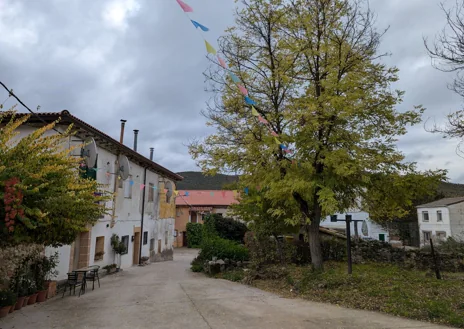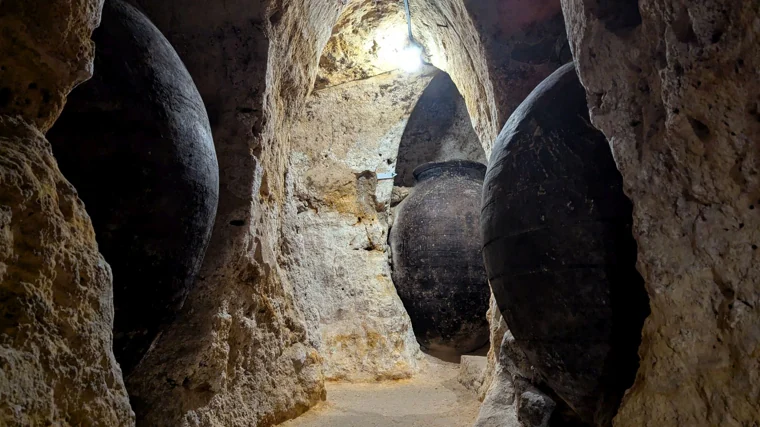Cívica is a place so picturesque – one could even say unreal – that, to describe it, many feel forced to compare it with exotic and distant landscapes. Maybe that’s where those titles that Google likes come from. A Cappadocia, a petraa Tolkien setting…. Up to the imagination of Camilo José Cela went too far to talk about this hamlet located near Brihuega (Guadalajara). «Cívica resembles a Tibetan village or the set of a Wagner opera. The traveler has never been to Tibet but imagines that its villages must be like this, solemn, miserable, almost empty, full of stairs and balustrades, hanging from the rocks and also pierced in the rock,” he wrote.
But Cívica draws attention on its own, without the help of hyperbole. The Romans probably lived here, and surely some hermits occupied in the 15th century the caves pierced in the tufa, a very porous limestone. What we see today, however, takes us to a more human story closer in time in a setting as unreal as ever: a rock wall with pierced caves. together with CM-201111 km from Brihuega, and a village at the top where a dozen people live in winter, and up to sixty or seventy in summer.
The modern era of the farmhouse begins in 1939, when it was purchased by a small group of families. In the 50s-60s, Don Aurelio, the priest, began to excavate the rock with his own hands and then with the help of some masons, perhaps with a religious idea of the caves, perhaps as a way of returning to the time when it was a hermitage… Until Eduarda, his housekeeper, crossed his path, with whom he had a long relationship. Worldly life led him to build two bars on the rock wall that were open for a long time, and that can now be visited.


The wall is made of tuff, a type of porous limestone rock that is easy to work with. Above these lines, some of the Cívica houses that are still inhabited. On the right, the interior of one of the two bars excavated by Aurelio.
The CM-2011 is a regional highway frequented by bikers and escorted by the Tajuñain a landscape lit in autumn. For some time now, at the height of Cívica you always see a few parked cars. Four years ago, Jaime, a resident of Barriopedro, a nearby village of twenty residents, bought the area where Aurelio worked (the two bars, his house, the access area to the caves…) for 50,000 euros, with the idea to access some type of subsidy to rehabilitate this then unknown heritage. He has cleared, cleaned, fitted out and started to build a small rural house that is not yet finished (“come back in three years”). He says that at this time has invested another 80,000 euros. He has no news about the subsidy.
Tourists pay two euros to access the farm. In exchange, they show them the prepared caves, the two bars that Aurelio excavated, they tell them the fascinating history of Cívica, the vertical wall with holes in it since time immemorial. And then they go up to the farmhouse. Jaime says that from the wall of the watchtower there is a tunnel of about three kilometers to the Torrecilla, that in the village Santa Catalina is venerated, with her festival in August, and that the fountain of the Seven Pipes (1797) is one of the first medicinal plants in Spain.

Arab caves of Brihuega
The Arab caves of Brihuega
As for tunnels, they are not strange in this area where limestone is so abundant. In nearby Brihuega there are seven kilometers of tunnels under its streets, many of them built in the 11th and 12th centuries. You can only see about 400 meters, but the experience is worth it. We enter through the Plaza del Cosoand those tunnels take us to another world full of enormous jars (built inside: it would have been impossible to carry them through the passages) and memories of many times where the underground city was an escape route or a hiding place. Some bat sleeps on the rock.
Brihuega has gained notoriety for its lavender fieldsso ‘instagrammable’ in summer, at harvest time. Throughout the year there are several shops full of violet tones that sell oils, perfumes, gels or liquors made from that plant. And then there is the historic center, the castle of the Piedra Bermejathe church of San Felipe (13th century). All of this is more than enough to organize a getaway. Including the unreal Cívica and other nearby districts: Castilmimbre, on a steep slope; Malacuera, Yela, Hontanares, Archilla, Tomellosa… all on the banks of the Tajuña, close to the Tajera reservoir.
#Cappadocia #picturesque #fascinating #hamlet #Alcarria

